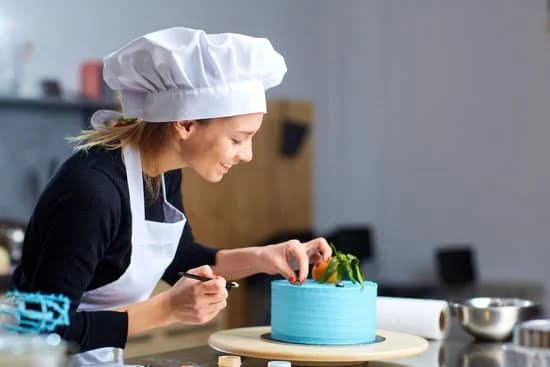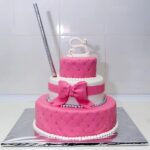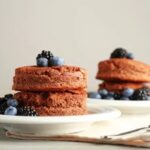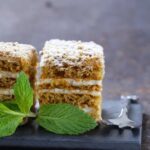Cake decorating materials are the key ingredients to creating stunning and visually appealing cakes. In this article, we will dive into the world of cake decorating and explore the various materials that play a crucial role in this art form. From essential tools such as piping bags and spatulas to different types of icing and frosting, fondant and gum paste, edible decorations, food coloring, specialized tools for advanced techniques, and even sustainable alternatives – we will cover it all.
To begin with, it is important to understand what cake decorating materials are. These are the tools, ingredients, and decorations used to transform a plain cake into a masterpiece. By using the right materials, decorators can elevate their creations from simple bakes to works of art. The importance of selecting high-quality materials cannot be stressed enough as they directly impact the overall outcome of the decoration process.
The development of cake decorating materials has come a long way over the years. From basic tools made out of wood or metal to modern innovations like silicone molds and airbrush kits, advancements have made cake decoration more precise and efficient. This brief overview sets the stage for exploring the essential tools needed for cake decorating in greater detail in the following section.
Essential Tools for Cake Decorating
Cake decorating requires a range of tools to achieve professional-looking results. Whether you are a beginner or an experienced cake decorator, having the right tools is essential. In this section, we will discuss some of the must-have tools for cake decorating and their purposes.
Piping Bags
Piping bags are indispensable for cake decorators as they allow for precise control when piping buttercream, royal icing, or other frostings onto cakes. They come in various sizes and materials such as reusable plastic or disposable options. Choosing high-quality piping bags that are comfortable to hold and easy to clean is important for achieving clean lines and smooth finishes in your decorations.
Spatulas
Spatulas are versatile tools that play a crucial role in spreading buttercream or ganache evenly on your cakes. Offset spatulas with a thin, flexible blade make it easier to reach into corners and create smooth edges. Straight spatulas can be used for a variety of tasks, from spreading fillings to smoothing sides and tops of cakes. Investing in spatulas made of sturdy materials with comfortable handles will make your cake decorating experience more enjoyable.
Cake Turntable
A cake turntable is an essential tool for every cake decorator. It allows you to easily rotate the cake while frosting or decorating, ensuring even coverage and precision. Look for a turntable that has a non-slip base and rotates smoothly without wobbling. A heavy-duty turntable with adjustable height is ideal for larger cakes or multi-tiered designs.
These are just a few examples of essential tools needed for cake decorating. Other necessary items include offset palette knives, fondant smoothers, cake levelers, flower nails, and various decorating tips for different piping techniques. When choosing your tools, opt for high-quality options that are durable and long-lasting. Investing in good quality tools not only ensures better results but also saves you money in the long run by providing tools that will last for many cakes to come.
Types of Icing and Frosting for Cake Decoration
When it comes to cake decoration, choosing the right icing or frosting is crucial. Different types of icing and frosting have unique characteristics that can greatly impact the final look and taste of your cake. In this section, we will explore some popular types of icing and frosting, discuss their pros and cons, and provide tips for selecting the right one based on your desired cake decorating techniques.
1. Buttercream:
Buttercream is a classic choice for cake decorators due to its versatility and delicious taste. Made from a combination of butter, powdered sugar, flavorings, and sometimes milk or cream, buttercream has a smooth texture that is perfect for frosting cakes. It can be easily colored and piped into various designs, making it ideal for intricate decorations. However, buttercream may not hold up well in warmer temperatures or humid environments as it has a tendency to melt.
2. Fondant:
Fondant is a pliable icing made primarily from sugar, water, corn syrup, and glycerin. It provides a smooth and flawless finish to cakes and allows for intricate designs to be sculpted on top. Fondant can be rolled out like dough and draped over the cake’s surface for a sleek appearance. One advantage of fondant is its ability to withstand higher temperatures without melting. However, some people find fondant less appealing in terms of taste compared to other icings.
3. Royal Icing:
Royal icing is traditionally used for creating delicate details on cakes such as lacework or fine lines. Made from powdered sugar and egg whites (or meringue powder), royal icing hardens when dried which makes it perfect for creating 3D decorations that need to stand upright on the cake’s surface. Its stiff consistency also enables easy piping work with clean edges. However, royal icing can be prone to cracking if not handled properly during application.
When selecting the right icing or frosting for your cake decoration, consider factors such as the climate or occasion, the desired design, and personal preferences. Experimenting with different types of icings can help you find the perfect match for your specific requirements.
Tips for selecting the right icing/frosting
- Take into account the weather: If you live in a hot and humid climate, it’s best to avoid buttercream as it may melt. Fondant or royal icing would be more suitable options.
- Consider the taste: Different icings have distinct flavors. If taste is a priority, sample various types before deciding which one to use.
- Think about the design: Some designs may require a smooth finish while others might call for intricate details. Choose an icing or frosting that is best suited for your desired design.
- Experiment with combinations: You don’t have to limit yourself to just one type of icing or frosting. Consider layering different flavors and textures to create unique and visually appealing cakes.
Fondant and Gum Paste
Fondant and gum paste are two essential ingredients in cake decoration that offer versatility and endless possibilities for creating stunning designs.
Overview of Fondant and Gum Paste
Fondant is a pliable, smooth icing that can be rolled out into thin sheets to cover cakes and create a flawless finish. It has a sweet taste and a slightly chewy texture.
On the other hand, gum paste is a firmer and more elastic type of icing that is often used to create intricate decorations such as flowers, figurines, or delicate details on cakes. Both fondant and gum paste can be purchased pre-made or made from scratch using simple ingredients like powdered sugar, gelatin, water, and flavorings.
Differences between Fondant and Gum Paste
While fondant and gum paste are similar in their malleability and ability to be shaped into various designs, there are some key differences between the two. Fondant is softer than gum paste, making it easier to work with when covering large cakes or achieving a smooth finish.
It also takes longer to dry compared to gum paste. On the other hand, gum paste dries harder and faster than fondant, making it ideal for creating delicate flowers or other detailed decorations that need to hold their shape.
Tips for Working with Fondant and Gum Paste
- Before working with either fondant or gum paste, ensure that your hands and work surface are clean and lightly dusted with powdered sugar or cornstarch to prevent sticking.
- Knead the fondant or gum paste until it becomes soft and pliable before rolling it out.
- To roll out the fondant or gum paste evenly, use a non-stick rolling pin or roll between two sheets of wax paper.
- When applying fondant to cover a cake, start from the center of the cake’s top surface and gently smooth it out towards the edges using a fondant smoother or your hands.
- To store unused fondant or gum paste, wrap it tightly in plastic wrap or place it in an airtight container to prevent drying out.
Edible Cake Decorations
When it comes to cake decoration, edible decorations offer a delightful and creative way to add flair to your cakes. Edible decorations not only enhance the visual appeal of your creations but also provide an extra element of taste and texture. From edible flowers to sugar pearls and sprinkles, there are countless possibilities for incorporating different decorations to achieve desired effects.
One popular option for adding elegance and sophistication to cakes is the use of edible flowers. Edible flowers bring a touch of natural beauty and can be used as standalone decorations or as part of a larger design. Some commonly used edible flowers include roses, pansies, and lavender. It’s important to note that not all flowers are safe to eat, so it’s crucial to use specifically labeled edible flowers or those grown without pesticides.
Another versatile option for edible decorations is sugar pearls. Sugar pearls come in various sizes, colors, and finishes, making them incredibly versatile for different cake designs. They can be used as borders or accents on cakes, giving them an elegant and refined look. Additionally, they can be combined with other elements like fondant or buttercream piping for a more intricate design.
Sprinkles are a classic choice for adding fun and color to cakes. They come in an extensive range of shapes, sizes, colors, and themes, making them suitable for any occasion or theme. Whether you’re decorating a birthday cake or a festive holiday treat, sprinkles offer a simple yet effective way to elevate the appearance of your cake.
To ensure the best results when using edible cake decorations, it’s essential to choose high-quality products that are safe for consumption. When purchasing ready-made decorations, look for reputable brands that use food-safe coloring agents and adhere to appropriate food hygiene standards. Alternatively, you can make your own edible decorations using ingredients like royal icing or modeling chocolate.
Incorporating edible decorations into your cake designs allows you to showcase your creativity while adding an extra dimension of flavor and texture. Whether you choose edible flowers, sugar pearls, or sprinkles, these decorations offer endless possibilities for personalizing and enhancing your cakes.
| Edible Decorations | Description |
|---|---|
| Edible Flowers | Natural and visually appealing decorations that can be used as standalone or part of larger designs. |
| Sugar Pearls | Versatile decorations available in various sizes, colors, and finishes; perfect for adding elegance to cakes. |
| Sprinkles | Fun and colorful decorations that come in different shapes, sizes, colors, and themes; suitable for any occasion or theme. |
Food Coloring
When it comes to cake decorating, one of the most exciting and essential materials to have in your toolkit is food coloring. Food coloring allows you to create vibrant and eye-catching palettes that can elevate the overall look of your cakes. In this section, we will explore the different types of food coloring available, techniques for achieving desired shades and consistency, and tips for avoiding common food coloring mistakes.
There are various types of food coloring that you can choose from, including gel, liquid, and powder forms. Gel food coloring is highly concentrated and provides intense colors without adding excess liquid to your batters or icings. It is perfect for achieving bold shades and keeps the consistency of your mixtures intact. Liquid food coloring is more readily available and often comes in small dropper bottles.
While it can be easier to find in stores, it may require larger amounts to achieve vibrant colors, which can affect the consistency of your batter or icing. Powdered food coloring is a versatile option that can be used in dry mixes as well as liquid-based recipes. It offers a wide range of colors and has a long shelf life.
To achieve desired shades with food coloring, it’s important to remember that less is often more. Start with a small amount of color and gradually add more until you reach the desired hue. Keep in mind that colors tend to intensify over time, so don’t panic if your mixture appears lighter at first.
Mixing colors can also help you achieve unique shades that perfectly match your design concept. Use a toothpick or small spatula to combine different colors on a palette before adding them to your mixture.
While using food coloring can be an exciting part of cake decoration, there are some common mistakes that decorators should be aware of. One common mistake is adding too much food coloring at once, which can result in an overpowering taste or alter the texture of your recipe. It’s always best to start with a small amount and gradually add more as needed.
Additionally, it is important to be mindful of the specific shades that different types of food coloring can produce. Some colors may appear differently in different mediums such as buttercream, fondant, or royal icing. To achieve consistent shades across your cake, it may be helpful to test your desired colors on a small portion of the medium before applying it to the entire cake.
By understanding the different types of food coloring available, utilizing effective techniques for achieving desired shades and consistency, and avoiding common mistakes, you can unlock a world of vibrant possibilities for your cake decoration. Embrace your creativity and experiment with different color combinations to make your cakes visually stunning and memorable. Remember, using high-quality food coloring will ensure that your creations not only look amazing but taste delicious as well.
Specialized Tools and Materials for Advanced Cake Decorating Techniques
Cake decorating is an art that allows enthusiasts to create stunning and intricate designs on cakes. While the essential tools discussed in the previous section are a must-have for any cake decorator, there are also specialized tools and materials that can take your cake decorating skills to the next level. These tools offer unique capabilities and allow decorators to achieve advanced techniques with precision and finesse.
One such tool is the cake stencil, which is used to create intricate patterns, logos, or designs on cakes. Cake stencils are typically made of food-safe plastic or metal and come in a variety of shapes and sizes. Decorators can use spray-on color or icing sugar to create beautiful patterns on their cakes using stencils.
Airbrush kits are another valuable tool for advanced cake decorating techniques. With an airbrush kit, decorators can effortlessly apply different colors, gradients, or shading effects onto their cakes, giving them a professional finish.
Fondant cutters are essential when working with fondant or gum paste. These specialty cutters have various shapes and sizes that allow decorators to cut out precise shapes or designs from rolled fondant. Fondant cutters come in a wide range of shapes such as flowers, leaves, letters, numbers, and more. They are perfect for creating delicate details on cakes or adding decorative elements.
As you advance in your cake decorating journey, it’s important to invest in these specialized tools as they open up a world of possibilities for creativity and innovation in your designs. However, mastering these advanced techniques requires practice and patience. It’s crucial to familiarize yourself with these tools’ uses and applications through online tutorials or workshops before attempting complex designs.
Sustainable and Environmentally-Friendly Cake Decorating Materials
In recent years, there has been a growing focus on sustainability and environmental consciousness in various industries, including the world of cake decorating. As consumers become more aware of the impact their choices have on the environment, there is a rising demand for sustainable and environmentally-friendly cake decorating materials. This section will delve into the options available for those looking to make eco-conscious choices in their cake decoration endeavors.
One of the key areas where sustainable alternatives have emerged is in piping bags. Traditional piping bags are often made from plastic which takes a long time to decompose and contributes to plastic waste. However, biodegradable piping bags have entered the market as an eco-friendly alternative.
These bags are typically made from materials like cornstarch or cellulose, allowing them to break down naturally over time without releasing harmful chemicals into the environment. By opting for biodegradable piping bags, cake decorators can enjoy guilt-free creativity without compromising on quality.
Another aspect of eco-friendly cake decorating materials is organic food coloring. Conventional food colorings often contain synthetic dyes that may not be environmentally friendly or healthy for consumption. Fortunately, there are now organic food coloring options available that use natural ingredients derived from sources like fruits, vegetables, and spices.
These organic food colorings provide vibrant hues while being free from artificial additives and chemical preservatives. Cake decorators can create stunning cakes that are not only visually appealing but also aligned with their sustainable values.
Additionally, compostable decorations have gained popularity among environmentally-conscious decorators. Instead of using conventional non-edible decorations made of plastic or other non-biodegradable materials, decorators can opt for decorations made from biodegradable substances such as rice paper or sugar-based materials. These decorations add a touch of elegance and uniqueness to cakes while breaking down naturally over time without causing harm to the environment.
| Eco-Friendly Cake Decorating Material | Properties/Advantages |
|---|---|
| Biodegradable Piping Bags | Break down naturally without releasing harmful chemicals |
| Organic Food Coloring | Made from natural ingredients, free from synthetic dyes and preservatives |
| Compostable Decorations | Break down naturally over time, made from biodegradable substances |
As the demand for sustainable options continues to grow, it is expected that more eco-friendly cake decorating materials will become available in the future. By making conscious choices in their material selection, cake decorators can join the movement towards a more sustainable and environmentally-friendly practice while maintaining artistic excellence.
Conclusion
In conclusion, having the right materials is crucial when it comes to cake decorating. Throughout this article, we have explored various cake decorating materials and their importance in achieving stunning results. From essential tools such as piping bags and spatulas to different types of icing and frosting, fondant and gum paste, edible decorations, food coloring, and specialized tools, each material plays a significant role in elevating your cake decorating skills.
By understanding the purposes and characteristics of each material, you can choose the right ones for your specific cake decoration needs. Whether you are a beginner or an advanced cake decorator, investing in high-quality tools and ingredients will make all the difference. Not only will they help you achieve professional-looking cakes, but they will also make your decorating process smoother and more enjoyable.
While it is important to familiarize yourself with traditional cake decorating materials, don’t be afraid to experiment with new ones. Try incorporating unique edible decorations or exploring sustainable alternatives for eco-friendly options. The world of cake decorating is constantly evolving, and by staying curious and open-minded, you can continue to innovate and expand your creativity.
Frequently Asked Questions
What are the materials used for decorating cake?
The materials commonly used for decorating cakes vary, but some of the most popular ones include frosting or icing, fondant, edible decorations like sprinkles or chocolate chips, piping bags and tips for creating elaborate designs, food coloring for tinting frosting or fondant, and tools like spatulas or offset spatulas for spreading frosting smoothly.
Depending on the desired design, additional materials such as cake stencils, edible glitter or dust, molds for shaping fondant decorations, and even fresh flowers may also be used.
What is the best thing to use to decorate a cake?
Determining the best thing to use to decorate a cake is subjective and depends on personal preference and the desired outcome. Frosting is a classic choice that can be easily spread or piped onto a cake to create different textures and patterns. Fondant offers a smooth finish and allows for more intricate designs or sculpted decorations.
Some people prefer a simple dusting of powdered sugar or cocoa powder for an elegant touch. Edible decorations like sprinkles or chocolate curls can add color and texture with minimal effort. Ultimately, it’s important to select decorating materials that align with one’s skills, taste preferences, and artistic vision.
What do I need to bake and decorate a cake?
To bake and decorate a cake, you will need several key ingredients and tools. For the cake batter itself, you’ll generally need flour, sugar, butter or oil, eggs, leavening agents like baking powder or baking soda (unless making a flourless cake), liquid ingredients like milk or water (depending on the recipe), flavorings such as vanilla extract or cocoa powder (if desired), and salt to enhance taste.
Additionally, baking pans of appropriate size and shape will be necessary.

Welcome to our cake decorating blog! My name is Destiny Flores, and I am the proud owner of a cake decorating business named Cake Karma. Our mission is to provide delicious, beautiful cakes for all occasions. We specialize in creating custom cakes that are tailored specifically to each customer’s individual needs and tastes.





